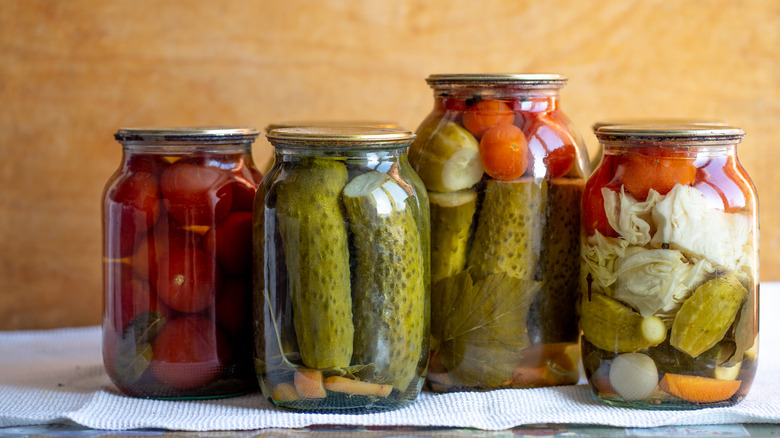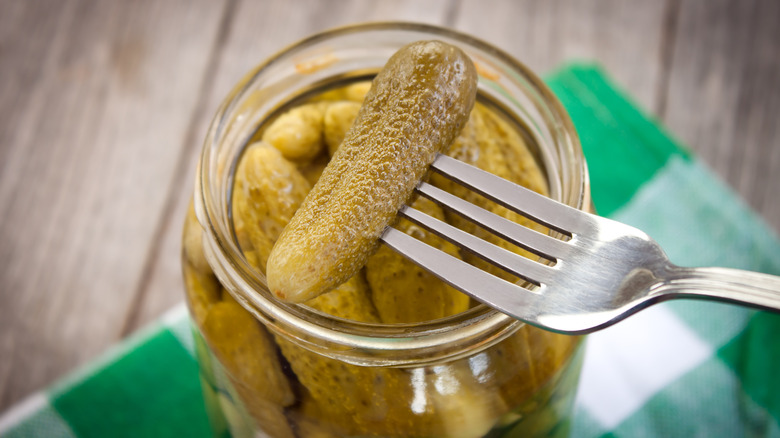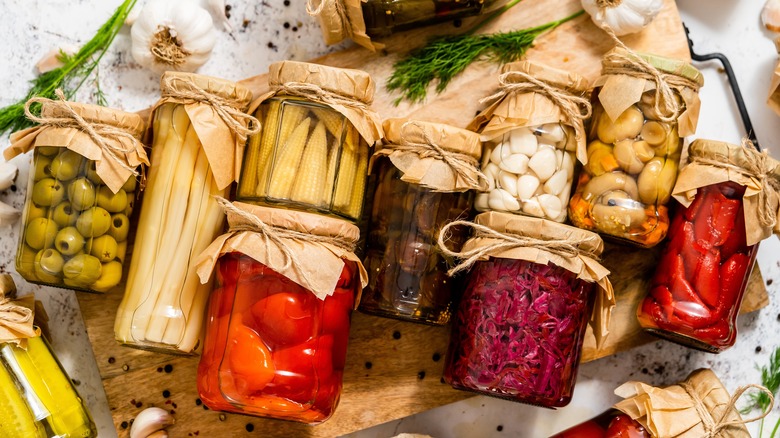The Ingredients Necessary To Classify A Certifiable Pickle
What is a pickle? You might think the answer is simple: A briny, crisp cucumber. In that case, why doesn't Claussen call its "Kosher dill slices" pickles? Is a piece of pickled pepper a pickle? What on earth is a cornichon?
The United States Department of Agriculture defines pickles clearly — and extensively. Pickles must be made "entirely or predominantly from cucumbers." Depending on the type of pickle, small amounts of cauliflower, onions, or other vegetables can be invited to the party, too. Once packed in a jar, they must be "prepared and preserved through natural or controlled fermentation or by direct addition of vinegar." Finally, the pickles' pH must be 4.6 or below.
The classic dill pickles you buy at the grocery store fall into this USDA-regulated category. (Major brands state that they just don't have room to print "pickles" on the jar.) Bread and butter discs, hamburger relish, and chow-chow are US government-approved pickles, too.
But across the culinary world, the word "pickle" can refer to so much more than brined cucumbers. Let's explore it.
How does a cucumber become a pickle?
The fact that the USDA requires pickles to have a 4.6 pH or below is a clue that there is some basic chemistry going on. Changes in acidity, actually: Pickled foods have been transformed by and preserved in acidic liquid. Acid keeps dangerous microbes out and tasty flavor in. Plus, pickle lovers appreciate the tang!
There are two ways to pickle a cucumber. One, you can preserve it in a salty brine. Over time, friendly bacteria will nibble on the cucumber and release acid. This process is called lacto-fermentation. Two, you can preserve it in a vinegar solution. Your pickle brine won't be brimming with gut-friendly microorganisms, but it will do the job.
Follow those steps, and your cucumber will be pickled — but it might not taste pickle-y. That's because mix-ins are also a common part of the pickle process. Bread and butter pickles require a healthy dose of sugar. People who prefer a more savory flavor might opt for garlic, dill, or mustard instead.
Other types of pickle
When you say "pickle" in North America, most people will picture a tangy, crunchy cucumber. But across the pond, a cheese and pickle sandwich won't come with cucumber at all; you're more likely to get a brown relish made from carrot, onion, and cauliflower, among other things. Why should cucumbers get to represent every pickled fruit and vegetable? There are countless delicious things you can pickle.
Branch out with other salty, tangy pickled vegetables. Middle Eastern-style pickled turnips go with shawarma like a pickle spear with a turkey club. Or try saffron pickled cauliflower: It would go just as well with rice as it does on a sandwich. You can pickle fruit, too (in addition to cucumbers, which are technically a fruit, of course). Pickled strawberries with peppercorn can be a surprising, sour-sweet sandwich topping.
That said, there's nothing wrong with the classics. If you want to make homemade pickles, start by picking up the right type of cucumber. Choose your favorite pickling method. Add your favorite extras. By the end, you'll know exactly what went into your pickles and why.


